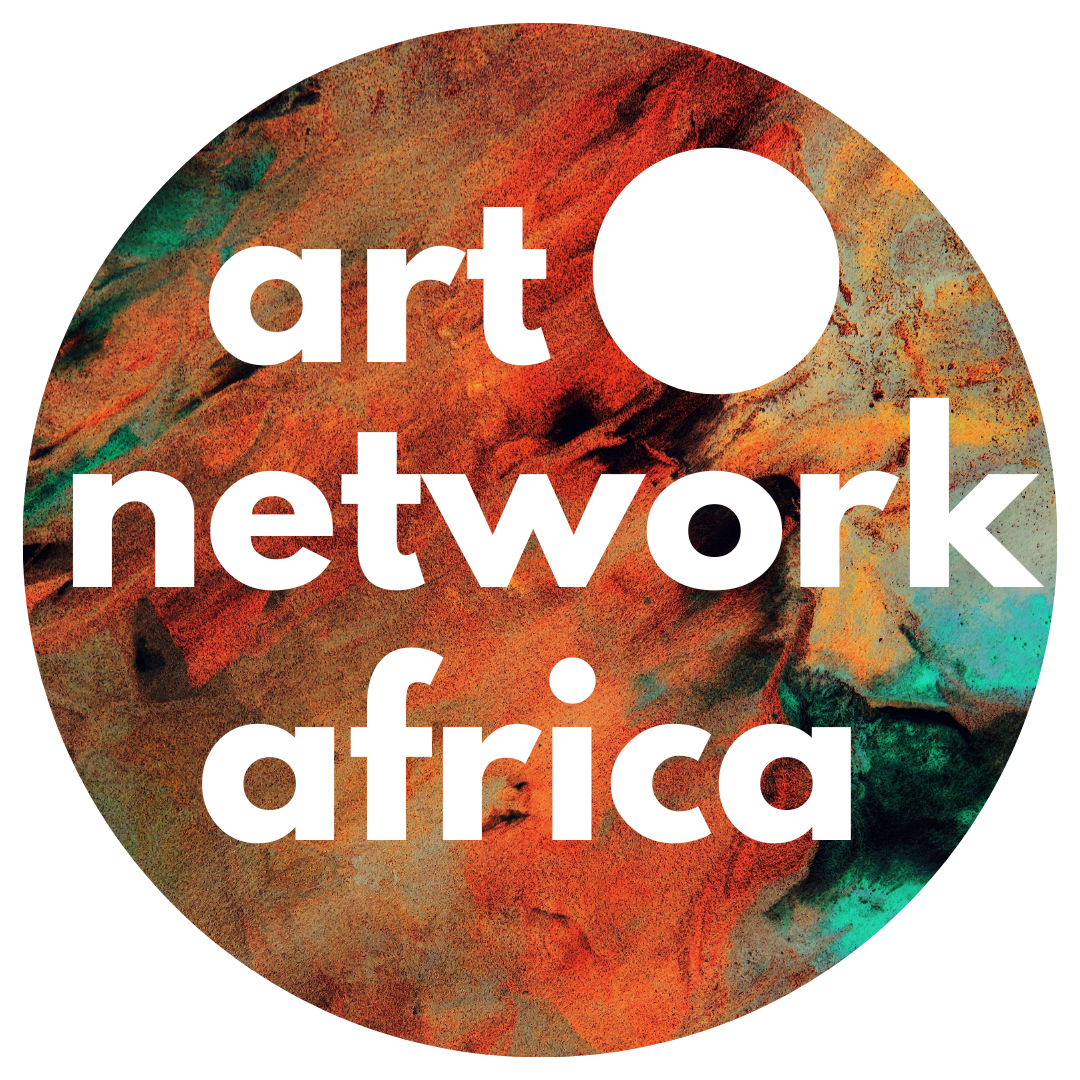As the global art world increasingly recognizes African contemporary art, Art Basel Miami Beach provides a critical platform for African artists to share their stories. This fair’s latest edition from the 6th to 8th of December, 2024 featured an impressive lineup of African artists, represented by various galleries. Through their art, they challenged perceptions, sparked conversations, and celebrated the diversity of the African experience with their distinctive styles and creative visions.
This fair features the following artists:
1. Ghada Amer (Egypt) and Serge Alain Nitegeka (Rwanda) – exhibited by the Marianne Boesky Gallery:
Displayed at Booth F12, A Night At The Boat by Ghada Amer explores the complexities of identity, delicately unraveling dualities—feminine and masculine, craft and art, figuration and abstraction, East and West—with nuanced precision and depth through the motif of threads. Next up is Serge Alain Nitegeka. His work, See Displaced Peoples in Situ (2024), uses the visual languages of minimalism and geometric abstraction, along with a stark, restrained color palette to reimagine the focus on color, line, and shape to explore the personal and political impacts of forced migration, displacement, and statelessness.


2. Yinka Shonibare CBE (Nigerian-British), Kaloki Nyamai (Kenya), Ranti Bam (Nigerian-British) and Elias Sime (Ethiopia) – exhibited by the James Cohan Gallery:
Displayed in Booth G22, Bronze Textile I, Yinka Shonibare’s hand-painted bronze sculpture, fuses African aesthetics with abstraction, capturing the dynamic movement of human migration and the complex histories of slavery, colonialism, and empire. With his signature Dutch-wax fabric style, Shonibare freezes a moment in time, evoking the fluidity of global exchange and the interconnectedness of cultures. The sculpture’s sail-like form embodies the turbulent journeys of people across the globe, underscoring the intricate web of power, identity, and memory.
Equally, Kaloki Nyamai’s multimedia piece, Ndikasyoka vaa inge, from her ongoing series, Dining in Chaos, is a powerful exploration of Nairobi’s collective memory, weaving together fragments of colonization, political unrest, and everyday life. By layering newsprint, images, and paint, Nyamai creates a complex narrative that reveals the intersections of past and present, trauma and resilience, and the fragile nature of memory itself.


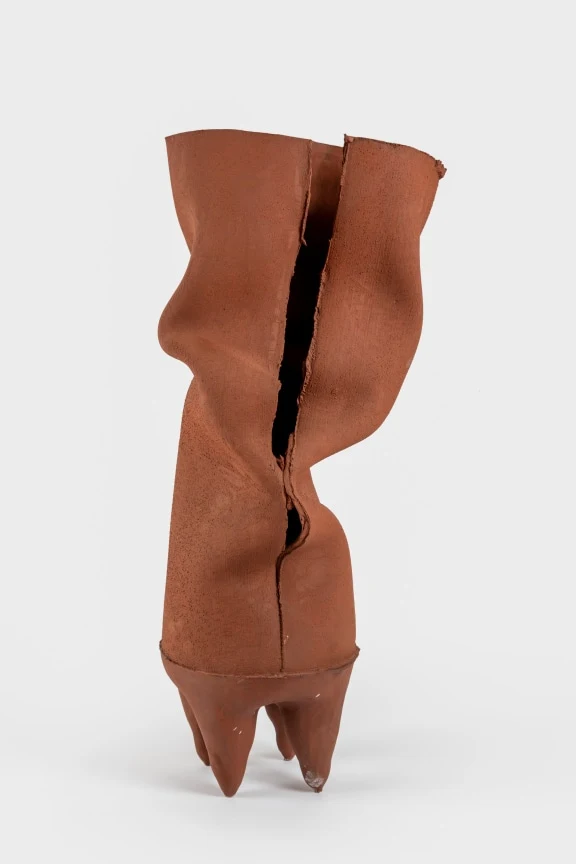
Ranti Bam, utilizes the tactile medium of red clay, exploring its essence as a physically grounding living material with (Four-leg) Red, a piece in her Ifa series that is currently underway. Bam physically engages with the red clay by embracing it before firing and this further embodies sculptures that portray a profound connection to the earth and the body. The piece’s textured, folded forms, paired with wooden plinths, create a sense of grounding, probing the boundaries between the tangible and the ineffable.
3. In a partnership, the Afriart Gallery and Rele Gallery exhibited the following artists respectively:
Located in Booth B27, the galleries featured artists exploring themes of identity, community, and environmental stewardship through works that harness traditional African wax prints, charcoal residue, sawdust, discarded paper, jute bags, fiber, and bark cloth. By moving away from conventional Western materials like canvas and paper, and employing materials homogenous to their communities and environment, these artists forge new pathways for storytelling, underscoring their commitment to sustainability and cultural heritage preservation. This collaborative booth garnered impressive recognition, ranking among Artsy’s 10 best booths at Art Basel Miami Beach 2024.
– Fiker Solomon (Ethiopia), Richard Atugonza (Uganda) and Sanaa Gateja (Uganda)– exhibited by the Afriart Gallery:
Fiker Solomon’s work reflects on the cycles of human emotions and nature, using biodegradable materials and textile techniques learned from her mother to transform traditional skills into artistic expression. Richard Atugonza uses waste materials like sawdust and charcoal residue to explore the human experience and our deep ties to nature, drawing on personal and shared stories to create evocative sculptures. While Sanaa Gateja is a mixed-media artist that incorporates recycled materials, bark cloth, and natural fibers into his abstract works in a way that blends installation, tapestry, and sculpture. His pieces weave materials into narratives reflecting Uganda’s social and political realities.

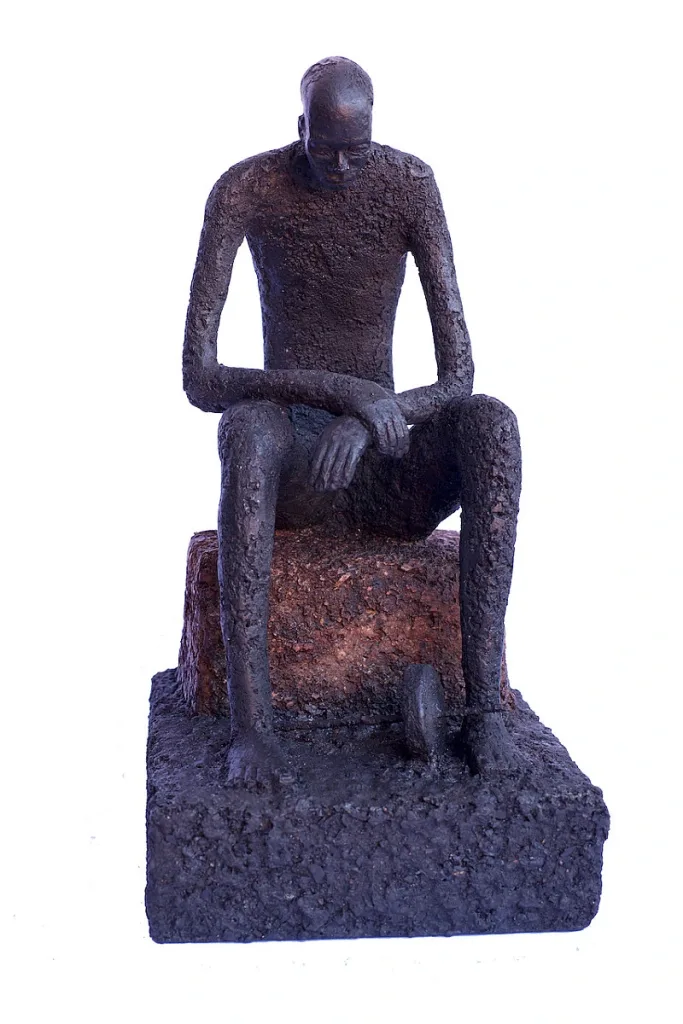

This exhibition essentially dismantled colonial narratives that have long sidelined African voices in global art, challenging notions of value and authenticity, and encouraging deeper engagement with the complexities of contemporary African identities.
– Peju Alatise (Nigeria), Sedireng Mothibatsela (Botswana) and Yoma Emore (Nigeria) – exhibited by the Rele Gallery:
On the opposite side of the Afriart gallery, a white wall demarcated the Rele gallery, showcasing three female artists – Peju Alatise, Sedireng Mothibatsela, and Yoma Emore – who harness art to convey powerful messages about their communities, focusing on girl and women’s empowerment, cultural preservation, tradition, and sustainability.
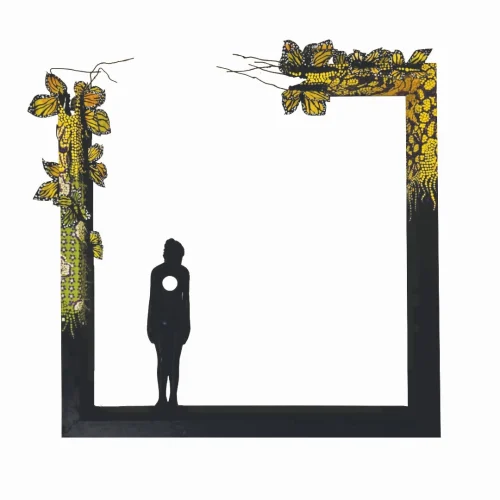
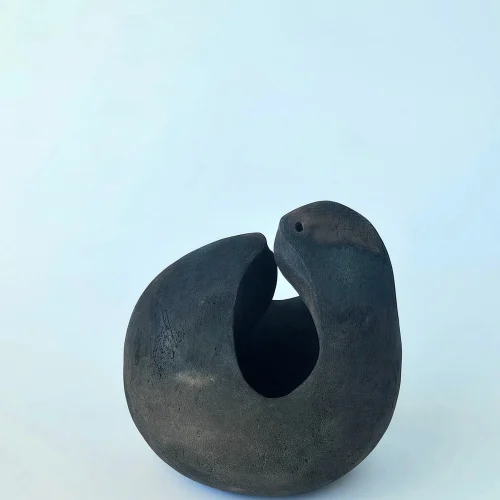

4. Atta Kwami (Ghana), Cassi Namoda (Mozambique), El Anatsui (Ghana), Ghada Amer (Egypt), Misheck Masamvu (Zimbabwe), Pamela Phatsimo Sunstrum (South Africa), Pélagie Gbaguidi (Benin), William Kentridge (South Africa) and Yinka Shonibare CBE (Nigerian-British) – exhibited by the Goodman Gallery:
Goodman gallery’s Booth E10 displayed a sublime array of contemporary African artists. Atta Kwami’s acrylic on calico piece, Untitled 3, fuses African patterns with modernist vision, inspired by textiles, jazz, and street architecture, expanding the boundaries of painting. El Anatsui’s Untitled I showcases his innovative use of discarded materials, transforming aluminum, copper wire, and nylon string into complex, visually striking assemblages to challenge colonialism, consumerism, and environmental waste.

Ghada Amer’s REVOLT is a powerful call to action, combining cotton appliqué with a potent Arabic quote to challenge oppressive systems and societal expectations, embodying her commitment to female empowerment. Through the medium of Oil on Canvas, Misheck Masamv’s Silent Mutterings, blends abstraction and figuration, probing power structures and historical legacies in Africa, illuminating decolonial perspectives.
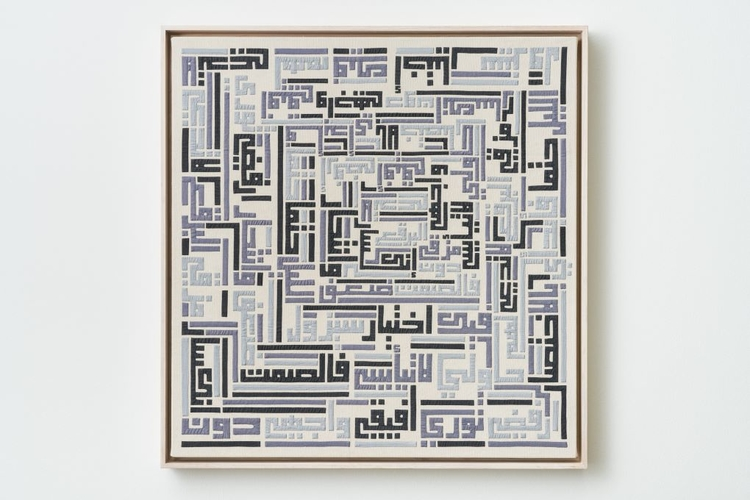
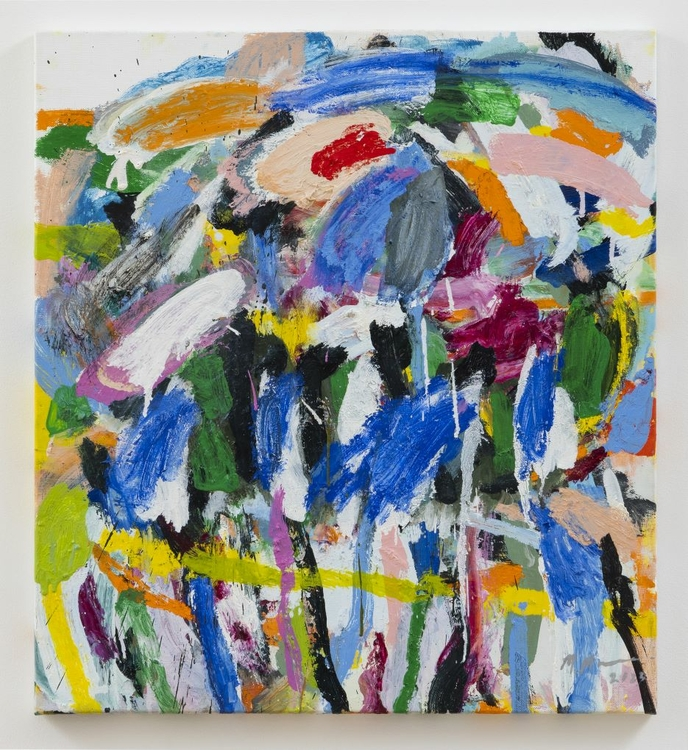
Pamela Phatsimo Sunstrum’s large-scale diptych Exit Permit (diptych) makes its US debut at the fair, following its European premiere and commission at the KM21 Museum. Pélagie Gbaguidi’s Le jour se lève: The Mutants is a powerful reckoning colonial and postcolonial histories through vibrant acrylic and pigment works, challenging binary thinking and official narratives. As a self-described ‘griot’, Gbaguidi embodies the West African storytelling tradition, bridging individual memory and ancestral past to uncover processes of forgetting and trauma.

William Kentridge employs the medium of paint, Indian ink, charcoal, coloured pencil and collage on paper in his presented works There Were No Books and Drawing for The Great Yes, The Great No (Jungle III). In Yinka Shonibare’s African Bird Magic, he fuses Dutch wax printed cotton with a contemporary flair, showcasing intricate patchwork, quilting and appliqué on hand-dyed silk. Another notable work on display is, Fabric Bronze IV. This sculpture captures the ephemeral power of wind, transforming Dutch-wax print fabric into a dynamic, three-dimensional sculpture that freezes time.


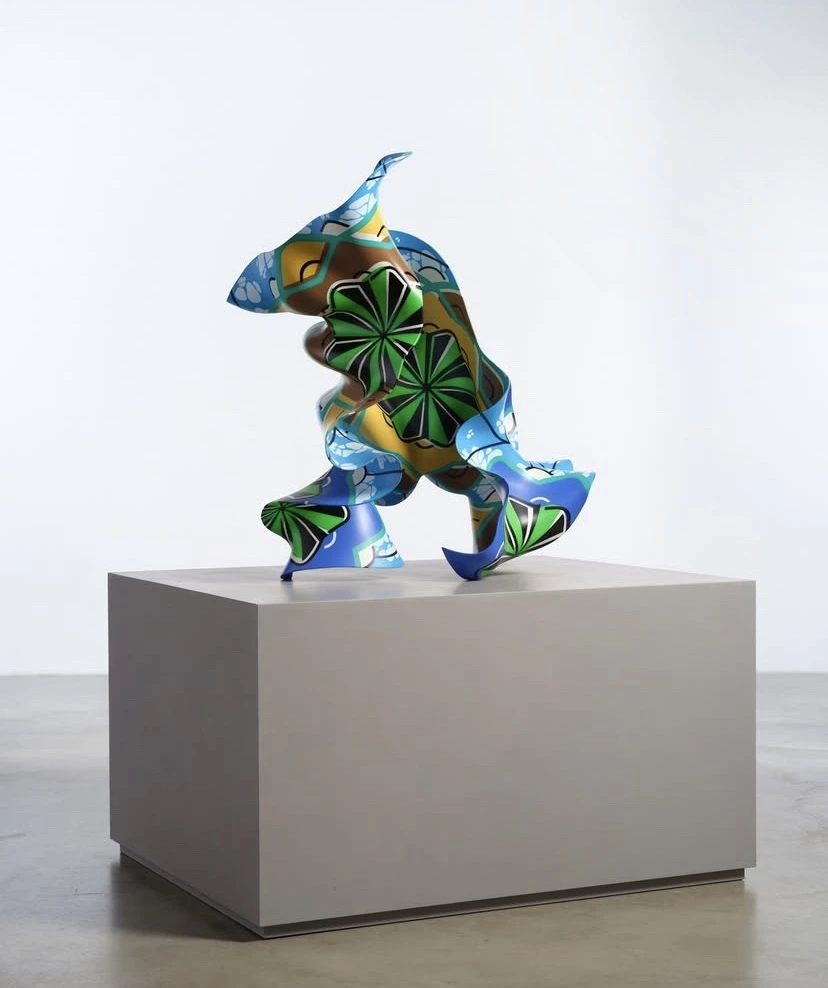
Cassi Namoda, who is famed for her vibrant, narrative paintings that blend cultural mythologies, historical narratives, and personal experiences, is also presented by the gallery. She merges Luso-African perspectives, literary, cinematic, and architectural influences, capturing the complexities of Mozambican life.
5. Ebun Sodipo – exhibited in collaboration with the Emalin Official & Soft Opening:
Sodipo’s artistic philosophy is showcased in Booth N18, where her thought-provoking works subvert notions of race, gender, sexuality, and power through meticulous research and storytelling. By combining Mylar and resin, Sodipo creates shimmering, immersive pieces that explore themes of transformation, desire, pleasure, and nostalgia. Through these mediums, Sodipo’s works manipulate light and shadow, reflecting on the complexities of identity, power, and self-perception, while obscuring and revealing truths about our surroundings.

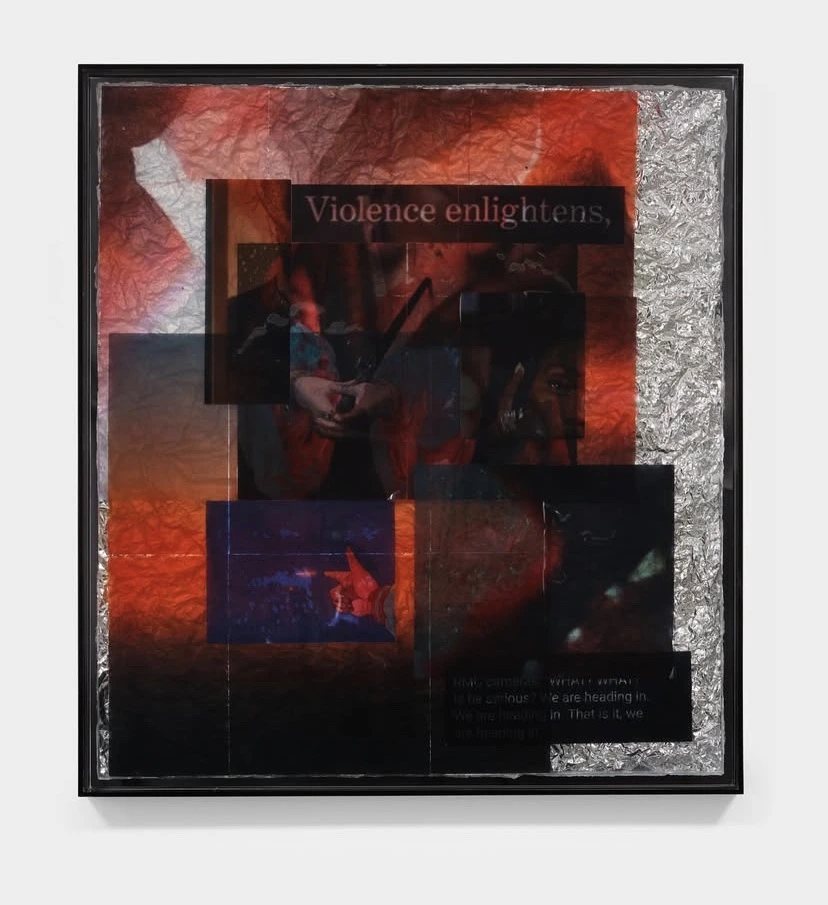
Art Basel Miami Beach stands as a testament to the growing influence and recognition of African artists in the global art arena. By providing a platform for these creatives, the fair not only celebrates the continent’s rich cultural heritage but also amplifies voices that challenge traditional narratives and expand the scope of contemporary art. The featured works embody a dialogue between history, identity, and innovation, urging viewers to engage with Africa’s dynamic artistic contributions in meaningful ways. As African artists continue to shape and inspire the global art discourse, their presence at such a prestigious event signals a powerful shift toward greater inclusivity, understanding, and appreciation in the art world.
